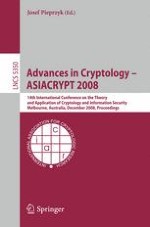2008 | Buch
Advances in Cryptology - ASIACRYPT 2008
14th International Conference on the Theory and Application of Cryptology and Information Security, Melbourne, Australia, December 7-11, 2008. Proceedings
herausgegeben von: Josef Pieprzyk
Verlag: Springer Berlin Heidelberg
Buchreihe : Lecture Notes in Computer Science
